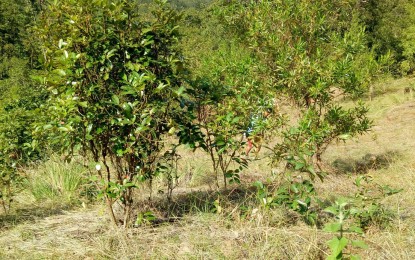
The tree species that are now thriving in the once grassland area in Candelaria, Zambales. (Photo courtesy of DENR-Central Luzon)
CITY OF SAN FERNANDO, Pampanga – At least 60 hectares of grassland in Zambales has been reforested through the use of a cost-efficient technology, according to the Department of Environment and Natural Resources (DENR) regional office here.
Arthur Salazar, DENR-3 deputy director, said in a press conference on Tuesday that a group of upland farmers from the Malatapi Community Livelihood Center, Inc. (MCLCI) in Candelaria, Zambales, has managed to reforest the area without planting any seedlings -- thus at no additional cost from the DENR -- but through the Assisted Natural Regeneration (ANR) method.
The MCLCI is a people’s organization (PO) and beneficiary of the DENR’s community-based forest management program (CBFMP).
“What these upland farmers did is to find surviving tree species or seedlings including wildlings in the grassland area, then, they uprooted the grass around the tree, combined with grass pressing by foot to clear the surrounding of the tree species from weeds. This method of forest restoration is technically called ANR,” he said.
Salazar said ANR is a cost-efficient technology of rehabilitating degraded forest land and shrub vegetation by taking advantage of trees already growing in the area, and by protecting and nurturing it.
“They have protected the tree species from grass fire and grazing by establishing fire lines or fire breaks to make sure its survival. They have also constructed a look-out tower for regular monitoring against any forest disturbance,” he said.
Minerva Martinez, chief of the conservation and development division (CDD) of DENR, said the MCLCI has replaced the cogon (Imperata cylindrical) and talahib (Saccharum spontaneum) vegetation in their area with surviving indigenous forest tree species.
She said some of the tree species that have been released from grass are now vigorously thriving in their area.
Paquito Moreno, Jr., executive director of DENR-Central Luzon, said ANR is a technology being promoted by the Association of South East Asian Nations-Republic of Korea (ASEAN- ROK) Forest Cooperation Organization (AFoCO) to fast-track the restoration of degraded forest lands and watershed with less cost to the government.
“This AFoCO project in Zambales is only one of the demonstrations of ANR technology. It is also being applied in Brunei Darussalam, Indonesia, and Singapore to improve the ASEAN region’s forest,” he explained.
He said the four-year project, which was started in 2016, has provided MCLCI with various skills trainings on ANR application, forest development, landscape restoration, and vulnerability assessment.
Recently, 16 international delegates from Singapore, Brunei Darussalam, Indonesia, and Korea visited the ANR area of MCLCI in Zambales to observe the successful implementation of the technology and exchange best practices and experiences in forest restoration, Salazar added.
MCLCI has 35 members, is registered with the Securities and Exchange Commission (SEC) since 1997, and a CBFM program beneficiary of DENR, managing more than 1,400 hectares of forestland.
AFoCO was first proposed by the Republic of Korea in June 2009 and was formally established in November 2011 with Brunei Darussalam, Cambodia, Indonesia, Laos, Malaysia, Myanmar, Philippines, Singapore, Thailand, and Vietnam as member-countries. (PNA)
